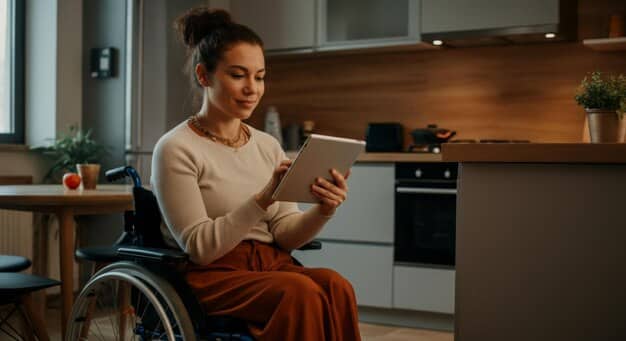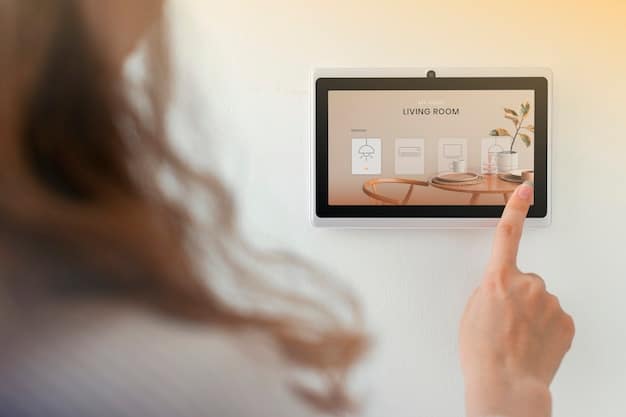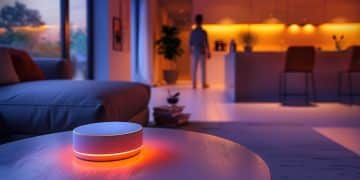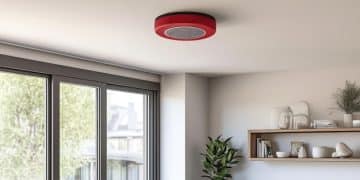Smart Home Technology for People with Disabilities: Enhancing Accessibility in US Homes

Anúncios
Smart home technology offers transformative accessibility solutions for people with disabilities in US homes, providing greater independence, safety, and an improved quality of life through voice control, automated systems, and remote monitoring capabilities.
Smart Home Technology for People with Disabilities: Enhancing Accessibility in US Homes is quickly becoming a beacon of independence and improved quality of life. From voice-activated assistants to integrated safety systems, these innovations are reshaping how individuals with diverse needs interact with their living spaces, offering practical solutions that foster self-sufficiency and comfort within the familiar confines of their own homes.
The Evolution of Smart Home Technology for Accessibility
The landscape of smart home technology has undergone a remarkable transformation, shifting from mere convenience to a vital tool for enhancing accessibility. Initially, smart devices were often seen as luxury items, but their potential to empower individuals with disabilities has driven significant innovation and adoption. This evolution is particularly resonant in US homes, where a growing emphasis on independent living and inclusive design has fueled the integration of these sophisticated systems.
Early iterations of smart home tech might have offered simple remote control for lights or thermostats. However, today’s ecosystems are far more integrated and intuitive. They leverage artificial intelligence (AI) and machine learning to understand user preferences and adapt to their needs, providing a level of customization previously unimaginable. This progressive refinement means that what was once a complex array of disparate devices now functions as a cohesive network, responding seamlessly to commands and environmental changes.
From Convenience to Necessity: A Paradigm Shift
What began as niche products designed for tech enthusiasts has blossomed into an essential suite of tools for many, particularly those seeking to overcome daily challenges imposed by physical or cognitive limitations. The shift from “nice to have” to “need to have” underscores the profound impact these technologies have on daily routines and overall well-being. For someone with limited mobility, a voice command to adjust the thermostat is not just easier; it can be the difference between comfort and discomfort, independence and reliance.
- Increased Independence: Users can control their environment without physical assistance.
- Enhanced Safety: Automated routines and emergency alerts minimize risks.
- Improved Quality of Life: Greater control leads to more comfortable and personalized living spaces.
- Reduced Caregiver Strain: Family members or professional caregivers can focus on other aspects of support.
The Intersection of Innovation and Inclusion
The rapid advancements in connectivity, sensors, and AI have catalysed this change. As devices become more interconnected and “smarter,” their ability to cater to diverse needs expands exponentially. Moreover, regulatory frameworks and advocacy groups have played a crucial role in pushing manufacturers towards more inclusive design principles, ensuring that new technologies are accessible by default, not as an afterthought.
The ongoing development of smart home technology promises even more sophisticated solutions. Future innovations may include predictive assistance, where systems anticipate needs based on learned patterns, further blurring the lines between assisted living and fully independent home environments. This continuous evolution is not just about new gadgets; it is about creating more equitable and empowering living spaces for everyone. The progress made reflects a broader societal understanding that technology’s true power lies in its ability to uplift and enable.
Key Smart Home Technologies Enhancing Accessibility
The heart of accessible smart home technology lies in its diverse range of devices and systems, each designed to address specific needs and challenges faced by individuals with disabilities. These technologies work synergistically, creating a comprehensive, adaptive environment that promotes independence and safety within US homes. Understanding the primary categories of these devices is crucial for appreciating their transformative potential.
Voice Control Systems: Empowering Interaction
Perhaps the most revolutionary aspect of smart home technology for accessibility is the advent of voice control systems. Devices like Amazon Echo (Alexa), Google Home (Google Assistant), and Apple HomePod (Siri) allow users to control various aspects of their environment using only their voice. This capability is invaluable for individuals with limited mobility, dexterity issues, or visual impairments, as it bypasses the need for physical interaction with switches or screens. Users can turn lights on or off, adjust thermostats, play music, or even lock doors just by speaking a command.
The sophistication of these systems extends beyond simple commands. They can be integrated with thousands of third-party devices, allowing for complex routines and personalized experiences. For example, a user could say, “Alexa, good morning,” and the system could automatically open blinds, turn on specific lights, and start the coffee maker.
Automated Lighting and Climate Control
Automated lighting systems provide significant benefits, especially for those with mobility impairments or visual challenges. Smart bulbs and switches can be controlled remotely via apps, voice commands, or even motion sensors. This eliminates the need to physically reach for light switches, reducing fall risks and making it easier to navigate a home, particularly at night.
Similarly, smart thermostats like Nest or Ecobee allow precise temperature control without needing to interact directly with the unit. Users can adjust settings from a smartphone app, through voice commands, or set schedules for automatic adjustments, ensuring comfort throughout the day and night without physical effort.
Smart Locks and Security Systems
For individuals with disabilities, managing home security can be a significant concern. Smart locks offer keyless entry, which is highly beneficial for those with dexterity issues, allowing them to unlock doors with a smartphone, a numerical code, or even voice commands. These systems also often include features like automatic locking and remote access for caregivers or family members.
Integrated security systems, including smart cameras and sensors, provide peace of mind. Users can monitor their homes from anywhere, receive alerts for unusual activity, and even communicate with visitors at the door through video doorbells. This enhances safety and provides a sense of security, which is paramount for independent living.
Accessible Entertainment and Communication
Smart TVs and streaming devices, often integrated with voice control, open up a world of entertainment for individuals who might otherwise struggle with traditional remote controls. Voice commands can change channels, adjust volume, or launch specific streaming services.
Furthermore, smart displays with video calling capabilities, like Amazon Echo Show or Google Nest Hub, facilitate easy communication with family and friends, which is especially important for those who may be socially isolated due to mobility challenges. These devices also offer accessibility features like screen readers and adjustable display settings.
Smart Appliances: Simplifying Daily Tasks
A growing number of smart appliances, from ovens to washing machines, come with features that enhance accessibility. Refrigerators that alert users when they are running low on groceries, ovens that can be preheated remotely, and washing machines that can be started and monitored from a smartphone app simplify daily tasks. While these smart appliances may not address every accessibility issue, they cumulatively contribute to reducing physical effort and cognitive load, promoting greater self-sufficiency in the home.
The continuous innovation in these areas ensures that smart home technology will remain a cornerstone in supporting independent living for people with disabilities, offering evolving solutions that cater to an ever-wider spectrum of needs.

Specific Benefits for Various Disability Types
The power of smart home technology lies in its adaptability, offering tailored solutions that address the unique challenges faced by individuals with diverse disability types. What might be a minor convenience for one person can be a life-changing enabler for another.
Benefits for Individuals with Mobility Impairments
For those with limited mobility, smart home technology transforms a home from a series of physical barriers into an accessible haven. The primary benefit is the ability to control various devices and aspects of the environment without requiring physical movement or assistance.
A person using a wheelchair, for instance, can struggle with reaching light switches, opening doors, or adjusting thermostats. Voice control systems become their primary interface for these tasks. Smart plugs allow ordinary appliances to be controlled remotely, eliminating the need to physically plug or unplug them. Automated door openers, integrated with smart locks, provide seamless entry and exit. Smart beds can adjust positions for comfort or to assist with transfers.
- Reduced physical strain: No need to reach, stretch, or exert force for common tasks.
- Increased self-reliance: Daily activities can be performed independently.
- Enhanced safety: Reduced risk of falls or accidents associated with difficult maneuvers.
Benefits for Individuals with Visual Impairments
Smart home technology offers aural cues and simplified interfaces that are crucial for those with visual impairments. Voice control is again paramount, allowing users to issue commands without visual input. Smart lighting systems with adjustable brightness and color temperature can also be beneficial, providing optimal illumination for varying levels of vision or to reduce glare.
Feedback from devices can be auditory, such as confirmations that a light has been turned on or a door locked. Smart appliances that provide spoken instructions or feedback (e.g., “oven preheated to 350 degrees”) enhance independence in the kitchen. Navigation apps integrated with smart devices can also help individuals orient themselves within their homes.
Benefits for Individuals with Hearing Impairments
For individuals with hearing impairments, visual alerts and haptic feedback are key. Smart doorbells equipped with flashing lights or smartphone notifications instead of just an audible chime can alert residents to visitors. Smoke and carbon monoxide detectors can similarly be linked to smart lights that flash or send alerts to a phone, ensuring vital safety warnings are not missed.
Video communication devices, beyond traditional phone calls, facilitate easier interaction. Smart displays that show captions for video content or provide visual cues for notifications are also highly beneficial. Some systems can even translate sounds into visual alerts—for instance, notifying a user via a flashing light if a baby cries or a dog barks.
Benefits for Individuals with Cognitive Disabilities
Smart home technology can offer structure, reminders, and simplified routines for individuals with cognitive disabilities, such as those with dementia or intellectual disabilities. Automated schedules can help maintain a consistent daily routine, prompting actions like “time to take medication” or “it’s bedtime” through auditory or visual cues.
Location tracking within the home can prevent wandering for those prone to it, alerting caregivers if a perimeter is crossed. Simplified interfaces, often designed with visual icons rather than complex text, make systems easier to understand and operate. Moreover, the ability to control the environment with minimal steps reduces cognitive load, allowing individuals to focus on other aspects of daily living. Caregivers can also remotely monitor and assist, providing support while fostering valuable independence for the individual.
Challenges and Considerations for Implementation
While the benefits of smart home technology for accessibility are undeniable, a pragmatic approach to implementation requires acknowledging and addressing several challenges and considerations. These range from the technical complexities of integration to the ongoing support needs and the crucial aspect of user privacy.
Cost and Affordability
One of the most significant barriers to widespread adoption is the cost. While basic smart devices have become more affordable, creating a fully integrated and customized accessible smart home can still involve substantial investment. This includes not only the cost of the devices themselves but also installation, potential modifications to existing infrastructure, and ongoing subscriptions for certain services.
Compatibility and Integration
The smart home market is highly fragmented, with numerous manufacturers producing devices that often operate on different protocols (e.g., Zigbee, Z-Wave, Wi-Fi, Bluetooth). Ensuring seamless compatibility and integration between various devices from different brands can be complex. Users might find themselves managing multiple apps or encountering interoperability issues, which can be frustrating and counterproductive to the goal of simplification. A unified smart home hub or platform can help mitigate this, but careful planning is essential.
Technical Expertise and Setup
Setting up and configuring a smart home system, especially one tailored for specific accessibility needs, often requires a degree of technical expertise. While many consumer-grade devices aim for “plug and play,” advanced integrations or troubleshooting can be challenging for users or their caregivers. The need for professional installation or ongoing technical support can add to the overall cost and complexity.
Privacy and Data Security Concerns
Smart home devices collect significant amounts of personal data, from voice commands and usage patterns to video footage and location information. This raises serious privacy concerns about how this data is stored, used, and protected. Users and their families must understand the privacy policies of different manufacturers and take steps to secure their networks. The risk of data breaches or unauthorized access is a valid concern, especially when sensitive information related to medical conditions or routines is involved.
Reliability and Dependence
The more a person relies on smart home technology for daily tasks, the more critical its reliability becomes. System outages, internet connectivity issues, or device malfunctions can severely impact an individual’s independence and safety. Redundancy planning, such as battery backups for essential devices, and a clear understanding of what happens when the system is offline, are important considerations. Users should also have alternative methods for performing critical tasks if the smart system fails.
User Adoption and Training
While technology can be empowering, successful implementation also depends on the user’s willingness and ability to adopt it. Some individuals, particularly older adults or those with certain cognitive conditions, may require extensive training and ongoing support to become comfortable and proficient with new systems. Simplifying interfaces and providing patient instruction are key to ensuring that the technology genuinely enhances, rather than complicates, their lives. Addressing these challenges head-on through careful planning, education, and selective product choice is vital for successful smart home accessibility.
Success Stories and Real-World Impact
The true measure of smart home technology’s value for people with disabilities lies not just in its theoretical capabilities but in its tangible, life-changing impact. Across the US, countless individuals are experiencing enhanced independence, safety, and a significantly improved quality of life thanks to these innovations. These success stories not only inspire but also highlight the practical applications and profound human benefits of accessible technology.
Empowering Independent Living
Consider the story of a veteran with a spinal cord injury who regained control over his living environment. Before smart home integration, even simple tasks like turning off a light or changing the TV channel required assistance. With a voice-controlled system, he can now manage his entire entertainment setup, adjust room temperature, and even greet visitors through a smart doorbell, all without leaving his wheelchair. This newfound autonomy has dramatically boosted his confidence and reduced his reliance on caregivers for everyday needs, allowing him to live more independently.
Another compelling example involves an individual with cerebral palsy who uses a head-controlled joystick for navigation. Integrating this existing control method with a smart home hub allowed her to operate room lights, adjust automated blinds, and even control an accessible bed, all through her familiar input device. This seamless connection removed numerous daily frustrations and fostered a greater sense of privacy and self-determination.
Enhancing Safety and Peace of Mind
For a family caring for an elderly parent with early-stage dementia, smart home technology offered crucial peace of mind. Motion sensors placed in critical areas, like the front door and kitchen, provided alerts if the parent wandered or if the stove was left on for too long. Smart smoke detectors linked to both sound and flashing light alerts ensured prompt notification in case of an emergency, accommodating for varying sensory perception. These systems didn’t replace human care but augmented it, allowing the family to monitor their loved one’s safety remotely and intervene when necessary, fostering a safer environment.
Overcoming Communication Barriers
A young adult with non-verbal autism found a new avenue for communication and control through integrated smart displays. By tapping on visual icons on a tablet or smart screen, he learned to indicate preferences for music, adjust room lighting, or even request specific activities, bypassing the need for complex verbal interaction. The consistent and predictable responses from the smart home system reinforced his communication attempts, leading to less frustration and a greater sense of agency within his home environment. This illustrates how technology can bridge communication gaps and provide alternative forms of expression.
Streamlining Daily Routines for Visually Impaired Individuals
A visually impaired professional successfully navigated her daily routine with the help of voice-activated appliances and tactile smart buttons. Her coffee maker starts automatically at a set time, lights respond to her voice commands as she moves through rooms, and her smart oven provides audio feedback on cooking status. This carefully curated ecosystem allows her to manage household tasks efficiently and safely, reducing the time and effort typically required for someone with visual impairments to complete daily chores. Her home is now a truly accessible space, built around her auditory and tactile interactions.
These narratives underscore the tangible difference smart home technology makes: it’s not just about gadgets; it’s about dignity, safety, and the fundamental right to live comfortably and independently within one’s own home. Each story serves as a powerful testament to the transformative potential of innovation when applied with inclusivity in mind.
Future Trends and Innovations
The landscape of smart home technology for accessibility is continuously evolving, with researchers and developers pushing the boundaries of what’s possible. Looking ahead, several trends and innovations are poised to further enhance independent living for people with disabilities in US homes, moving beyond current capabilities into more predictive, empathetic, and seamlessly integrated systems.
Seamless Integration and Interoperability
One of the most significant future trends is a greater emphasis on seamless integration and interoperability. The fragmented nature of today’s smart home market, where devices from different brands often struggle to communicate effectively, is a major hurdle. Initiatives like Project CHIP (Connected Home over IP), now known as Matter, aim to create a unified industry standard. This will allow devices from various manufacturers to work together effortlessly, simplifying setup, expanding user choice, and creating truly cohesive smart home ecosystems. For accessibility, this means fewer compatibility headaches and more robust, reliable systems.
Advanced AI and Machine Learning
The role of Artificial Intelligence and Machine Learning will become even more central. Future smart home systems will be less about reacting to commands and more about anticipating needs based on learned patterns and preferences. This could include predictive lighting adjustments based on natural light cycles and user activity, or proactive temperature regulation based on known comfort zones and upcoming weather changes. AI-powered systems might also identify changes in routine or unusual activity, subtly alerting caregivers to potential issues before they escalate.
Wearable Integration and Biometric Monitoring
The convergence of smart home technology with wearables and biometric monitoring devices holds immense promise. Smartwatches, fitness trackers, and other sensors could provide real-time health data (e.g., heart rate, sleep patterns, fall detection) that integrates with the smart home system. For instance, a fall detected by a wearable could automatically trigger an alert to emergency contacts, unlock the front door for first responders, and turn on lights to guide them. This creates a proactive safety net, particularly for elderly individuals or those with medical conditions.
Personalized and Adaptive Environments
Future smart homes will be even more personalized and adaptive. Systems will learn individual preferences and adjust environments accordingly, taking into account sensory sensitivities. For example, lighting might adjust not just for brightness but also for color temperature to reduce eye strain, or soundscapes might be generated to soothe or stimulate, based on a user’s known responses. This level of customization moves beyond basic control to create truly therapeutic and supportive living spaces.
Robotics and Assistive Automation
While still in early stages for residential use, the integration of robotics will likely grow. Robotic assistants could help with tasks like retrieving objects, opening doors, or even assisting with personal care. Small, automated cleaning devices are already common, but future robotic platforms could be more versatile and integrated, providing physical assistance beyond simple household chores. This would represent a profound leap in enabling physical independence for those with severe mobility limitations.
Augmented and Virtual Reality for Home Control
Emerging augmented reality (AR) and virtual reality (VR) technologies could offer new interfaces for smart home control. Imagine being able to “see” and interact with smart devices virtually, or using AR overlays to navigate a room, identify objects, or find switches. This could be particularly beneficial for individuals with visual impairments or those who find traditional interfaces challenging. While not mainstream for home control yet, the potential for intuitive and immersive interaction is significant.
These future trends paint a picture of a smart home that is not just connected, but truly intelligent, empathetic, and seamlessly integrated into the lives of its inhabitants, maximizing accessibility and empowering individuals with disabilities to live their fullest lives at home.
Choosing the Right Smart Home System for Your Needs
Navigating the myriad of smart home technologies available can be overwhelming, especially when the goal is to optimize for specific accessibility needs. Selecting the right system requires careful consideration, detailed planning, and a clear understanding of individual requirements and preferences. It’s not a one-size-fits-all solution, but a tailored journey towards an empowered living space.
Assess Individual Needs and Priorities
The first and most crucial step is to conduct a thorough assessment of the individual’s specific needs, daily routines, and the challenges they face. What aspects of daily living cause the most difficulty? Are there mobility issues, visual impairments, cognitive challenges, or a combination? Prioritize the functions that would offer the greatest benefit. For example, if mobility is the primary concern, voice control for lights, doors, and thermostats might be paramount. If safety is key, consider integrated sensors and emergency alerts.
* Identify key pain points: Where does the individual struggle most in their home?
* Prioritize functionality: What features would have the biggest positive impact?
* Consider future needs: Will the system need to adapt over time as needs change?
Research Compatibility and Ecosystems
Once needs are identified, research smart home ecosystems. Major players like Amazon Alexa, Google Home, and Apple HomeKit offer robust platforms, but they vary in their compatibility with third-party devices and their strengths in specific areas. Some systems are more open, allowing for a wider range of connected devices, while others are more locked down but offer tighter integration. Look for systems known for their strong accessibility features and broad device support relevant to your needs. This research will help avoid future compatibility headaches.
Consider Ease of Use and User Interface
The best technology is useless if it’s too difficult to operate. Look for systems with intuitive user interfaces, whether that’s through voice commands, large buttons on a tablet, or simplified visual menus. For individuals with cognitive disabilities, simpler, consistent interfaces are essential. For those with dexterity issues, voice control or touch-free sensors are preferable. Consider how the individual will actually interact with the system daily and choose the most comfortable and efficient method.
Evaluate Installation and Ongoing Support
Determine whether professional installation is required or if the system can be set up independently. Some complex systems might benefit from expert installation to ensure optimal performance and integration. Also, factor in ongoing support: Is technical assistance readily available? Are there community forums or dedicated support channels for accessibility-related questions? For some, having a reliable support system in place can be as important as the technology itself.
Factor in Security and Privacy Measures
As discussed, security and privacy are paramount. Investigate the security protocols of potential systems. Are they encrypted? How is data collected and used? Choose reputable brands with a strong commitment to user privacy. Enable strong passwords, two-factor authentication, and secure your home Wi-Fi network. Understand that some level of data sharing is often inherent, but choose systems with transparent policies.
Start Small and Expand
For many, a staged approach is advisable. Instead of outfitting an entire home at once, start with a few key devices that address immediate needs. This allows the user to become comfortable with the technology, assess its effectiveness, and identify any unforeseen challenges. Once proficiency and satisfaction are achieved, the system can be gradually expanded to include more devices and functionalities. This incremental approach makes the transition smoother and more manageable.
By systematically addressing these considerations, individuals and their families can make informed decisions, ensuring that the chosen smart home system truly enhances accessibility, independence, and overall quality of life in their US homes.
Ensuring Data Privacy and Security in Smart Homes
As smart home technology becomes increasingly integrated into the lives of people with disabilities, the importance of ensuring data privacy and security cannot be overstated. These systems collect and process a wealth of personal and sensitive information, from daily routines and health data to movement patterns and voice commands. Safeguarding this data is crucial to maintaining trust and preventing potential misuse.
Understanding the Data Collected
Smart home devices operate by continuously collecting data about their environment and user interactions. Voice assistants record commands, smart cameras capture video, motion sensors track movement, and smart thermostats log temperature preferences. This information is often sent to cloud servers for processing and analysis. For individuals with disabilities, this data can be particularly sensitive, as it might reveal details about their health conditions, medication schedules, or dependency levels. Understanding what data is collected and how it’s used is the first step toward managing privacy.
Choosing Reputable Brands and Secure Devices
The selection of smart home devices and platforms is critical. Opt for products from well-established companies with a proven track record in security and privacy. Research their data privacy policies and terms of service. Look for features like end-to-end encryption for communication between devices and servers, and regular security updates. Avoid generic or inexpensive devices from unknown manufacturers, as they might have weaker security protocols or less transparent data handling practices.
Securing Your Home Network
The foundation of a secure smart home is a robust home network.
- Strong Passwords: Use unique, complex passwords for your Wi-Fi network and all smart devices. Change default passwords immediately upon setup.
- Two-Factor Authentication (2FA): Enable 2FA wherever available for all smart home accounts. This adds an extra layer of security by requiring a second verification method.
- Network Segmentation: If possible, create a separate “guest” Wi-Fi network specifically for smart devices. This isolates them from your main network, protecting more sensitive data on your computers and smartphones.
- Firewall and Router Security: Ensure your router’s firewall is enabled and keep its firmware updated. Consider a quality internet security suite that offers network protection features.
Managing Device Settings and Permissions
Many smart devices offer privacy settings that can be customized. Take the time to review and adjust these. For example, you might be able to:
- Disable microphone recording when not in use.
- Limit data sharing with third-party applications.
- Control access to video feeds or location data.
Regularly audit the permissions granted to smart home apps and revoke any that are unnecessary. Be cautious about granting access to personal contacts, calendars, or other sensitive information unless absolutely required for functionality.
Regular Software Updates
Software vulnerabilities are common targets for cyber attackers. Enable automatic updates for all your smart home devices and their accompanying apps. These updates often include critical security patches that protect against newly discovered threats. Regularly check for manual updates if automatic updates are not available for a specific device.
Educating Users and Caregivers
For smart home technology to be truly secure, all users, including family members and caregivers, must be aware of best practices. Educate them on safe usage, the importance of strong passwords, recognizing phishing attempts, and understanding the privacy implications of their interactions with the devices. Consistent awareness and adherence to security measures are vital in maintaining a secure smart home environment for everyone, particularly for those whose independence relies heavily on these interconnected systems.
| Key Benefit | Brief Description |
|---|---|
| ♿️ Enhanced Independence | Smart devices enable control over lights, climate, and appliances, reducing reliance on others for daily tasks for those with mobility issues. |
| 🚨 Increased Safety | Features like smart locks, remote monitoring, and automated alerts respond to emergencies and provide peace of mind. |
| 🗣️ Intuitive Interaction | Voice control and simplified interfaces make technology accessible to users with varied physical and cognitive abilities. |
| 🔄 Tailored Solutions | Systems can be customized to meet specific needs of individuals with different types of disabilities, from visual to cognitive impairments. |
Frequently Asked Questions
Smart home technology for accessibility encompasses devices and systems designed to enable individuals with various disabilities to control their home environment, manage daily tasks, and enhance safety and independence. This includes voice-activated assistants, smart lighting, automated door locks, climate control systems, and integrated security features, all controllable through accessible interfaces like voice or adapted switches.
For individuals with mobility impairments, smart home technology significantly reduces the need for physical movement. They can control lights, adjust thermostats, open and lock doors, and operate appliances using voice commands or remote controls, eliminating the struggle to reach switches or access physical devices, thus fostering greater independence and reducing physical strain in daily living.
While the cost of smart home technology varies widely, basic smart devices are becoming increasingly affordable. A fully integrated system designed for comprehensive accessibility can be a significant investment, but many solutions can be implemented incrementally to manage costs. Government programs, grants, and non-profit organizations may also offer financial assistance or resources for accessible home modifications.
Privacy concerns include the collection of sensitive personal data, such as routines, health information, and voice recordings. It’s crucial to choose reputable brands with strong security protocols, use robust passwords, enable two-factor authentication, and secure your home network. Regularly review and adjust privacy settings on all devices and apps to control data sharing and ensure sensitive information remains protected.
To choose the right system, first assess the individual’s specific challenges and prioritize the most impactful features. Research compatible ecosystems like Amazon Alexa or Google Home. Consider ease of use, required technical expertise for setup, and available ongoing support. Always factor in data security and privacy measures. It’s often beneficial to start with a few key devices and gradually expand the system.
Conclusion
The integration of Smart Home Technology for People with Disabilities: Enhancing Accessibility in US Homes is not merely a technological advancement but a profound social step towards greater inclusivity and independence. These innovations empower individuals to navigate their living spaces with increased autonomy, enhance their safety, and significantly improve their overall quality of life. While challenges related to cost, compatibility, and privacy persist, the ongoing evolution and widespread adoption of these systems promise an even more accessible future. As technology continues to grow more intuitive and integrated, its capacity to support diverse needs will only expand, reinforcing the home as a sanctuary of independence and personal control for all.





